 As we reported in New Build: Foundations for a successful housing policy? the Autumn Statement heralded significant reforms to Stamp Duty – the UK tax on house purchases. The result is the introduction of a graduated system of tax, along the lines of the income tax system. A similar regime will continue to operate in Scotland when the Land and Buildings Transactions Tax replaces Stamp Duty next April. Here we consider the impact on the effective rates of tax following the changes to Stamp Duty.
As we reported in New Build: Foundations for a successful housing policy? the Autumn Statement heralded significant reforms to Stamp Duty – the UK tax on house purchases. The result is the introduction of a graduated system of tax, along the lines of the income tax system. A similar regime will continue to operate in Scotland when the Land and Buildings Transactions Tax replaces Stamp Duty next April. Here we consider the impact on the effective rates of tax following the changes to Stamp Duty.
Under the old system any house purchase involving a property whose value was £125,000 or less incurred no Stamp Duty liability. Thereafter, one of five tax rates applied: 1% above £125,000 to £250,000, 3% above £250,000 to £500,000, 4% above £500,000 to £1m, 5% above £1m to £2m and 7 per cent for properties over £2m. The important point was that the whole of the purchase price was subject to one of these five progressively higher tax rates.
The new system sees the introduction of a graduated system of tax which means that the amount paid by house purchasers will be dependent upon the proportion of the value of the property that falls in each of the tax bands. Again, for properties up to £125,000 there will be no liability. There will then be four bands: 1% above £125,000 to £250,000, 5% above £250,000 up to £925,000, 10% above £925,000 up to £150,000 and 12% above £150,000.
One significant impact of the changes is that the liability will be more proportionate to the value of the property. To see this we can compare the average rate of tax under the new and old tax system. The average rate of tax is simply the amount of the tax liability relative to the price of the property.
 From Chart 1 we can see how the new average rate of tax under rises progressively with the price of the property. (Click here to download a PowerPoint of the chart). Under the old system, the profile of the average rate of tax looks like a series of steps with a slab at each tax rate. Unsurprisingly, the system was sometimes referred as the ‘slab system’.
From Chart 1 we can see how the new average rate of tax under rises progressively with the price of the property. (Click here to download a PowerPoint of the chart). Under the old system, the profile of the average rate of tax looks like a series of steps with a slab at each tax rate. Unsurprisingly, the system was sometimes referred as the ‘slab system’.
A second significant change will be the removal of the significant spikes in the marginal rate of tax around each of the tax bands. For example, the tax liability on a property costing £125,001 was £1,250.01 compared with a zero liability on a property costing £125,000. Therefore, a £1 rise in the price of property was accompanied by a £1,250.01 rise in the purchase tax. In percentage terms this is a marginal rate of tax of 125,001. Chart 1 shows how the marginal rates now match the progressively higher tax rates that become payable between each threshold.
The principle of removing the significant distortions to pricing created by the old system of Stamp Duty is likely to receive general approval. However, there may be some unease around the short-term implications for house prices of the bands and rates under the new system. This is largely because nobody purchasing a property at £937,000 or less will see their tax liability rise. The reduction in the liability raises concerns about a potential boost to house prices.
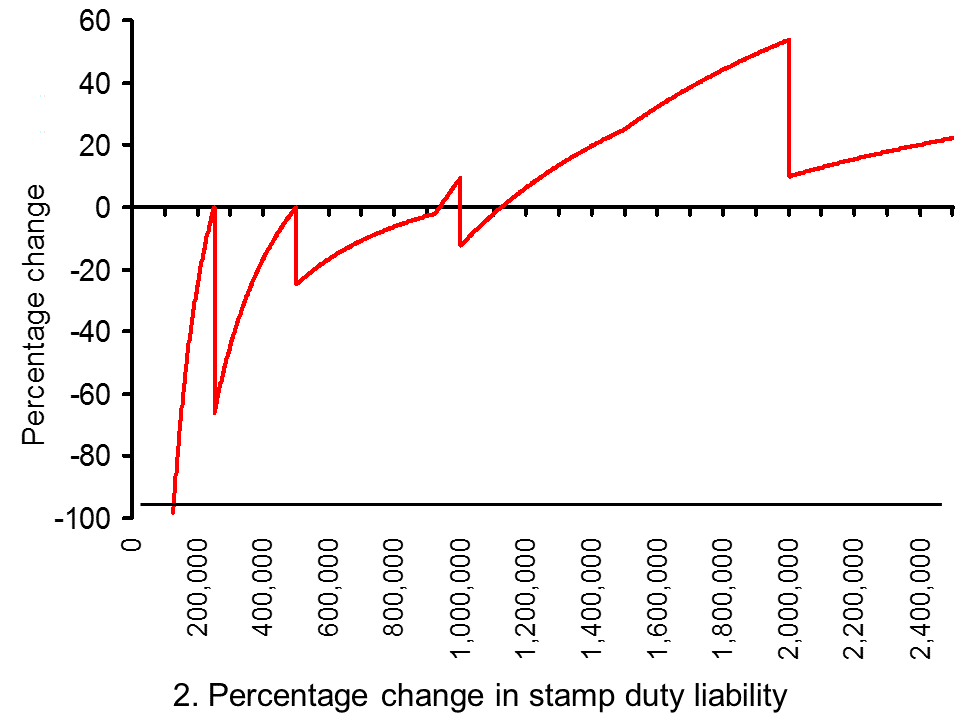 Chart 2 show the percentage change in the Stamp Duty liability for properties of up to £2.5 million. (Click here to download a PowerPoint of the chart.) The average UK house price, excluding London, is currently £235,000. The stamp duty saving in this case is £150 or 6.4 per cent.
Chart 2 show the percentage change in the Stamp Duty liability for properties of up to £2.5 million. (Click here to download a PowerPoint of the chart.) The average UK house price, excluding London, is currently £235,000. The stamp duty saving in this case is £150 or 6.4 per cent.
But there are more significant savings than this from the reforms, including in London where inflationary pressures in the housing market have been more significant. Here annual price inflation ran at close to 20 per cent in the second and third quarters of the year. Given that the average house price in London is currently £510,000, this means a Stamp Duty saving of £4,900 or 24 per cent. Of course, for premium London markets (and other similar markets elsewhere) a quite different effect could arise. The liability on a £2m property rises by 53.75 per cent. Nonetheless, for most markets it is the boost to prices that is most concerning.
In the East Midlands, which is a good barometer of the market in the rest of the country, there will be a saving of £610 or 32 per cent on the current average property purchase of £189,000. Therefore, even in markets where house price inflation is more subdued there is the potential that the changes to the Stamp Duty system will, in the short term at least, boost housing demand and fuel house price growth.
Stamp Duty/Land and Buildings Transactions Tax
Rates and allowances: Stamp Duty Land Tax Gov.UKLand and Buildings Transaction Tax Revenue Scotland
Autumn Statement
Autumn Statement: documents Gov.UK
Articles
The home owners cashing in on stamp duty reforms Telegraph, Dan Hyde (2/12/14)
Christmas comes early for estate agents after stamp duty changes Guardian, Nigel Bunyan (7/12/14)
Stamp duty: House price boom and mansion bust Telegraph, Anna White (6/12/14)
£200m house deal stampede by wealthy to beat stamp duty hike: Reforms spark one of busiest periods for estate agents in 25 years Daily Mail Online, Louise Eccles and Ruth Lythe (5/12/14)
Stamp duty changes boost housing market and push up prices Guardian, Hilary Osborne (5/12/14)
Stamp Duty revamp blow to SNP property tax reforms Scotsman, Tom Peterkin and Jane Bradley (4/12/14)
 Autumn Statement: What do stamp duty changes mean? BBC News, (3/12/14)
Autumn Statement: What do stamp duty changes mean? BBC News, (3/12/14)
Data
House Price Indices: Data Tables Office for National Statistics
Questions
- What is the tax base of Stamp Duty and the Land and Buildings Transaction Tax?
- How does Stamp Duty distort choices?
- Under the old Stamp Duty system, why might a seller be reluctant to put their property on the market at £251,000?
- What is meant by the average and marginal rates of tax?
- What is meant by a progressive tax?
- What is the connection between the average rate of tax and how progressive a tax is?
- Calculate the marginal rates of tax (in percentage terms) under the old Stamp Duty system following a £1 rise which results in a property’s value moving into the next tax band (start with a £1 rise from £125,000 to £125,001).
- Using a demand-supply diagram show the effect of the Stamp Duty reforms on house prices in most UK housing markets. What characteristics of supply would make the change in price particularly large?
- Are there any housing markets where demand could fall following the introduction of the reforms to Stamp Duty? Illustrate the possible effects using a demand-supply diagram.
- How might an economist go about evaluating the Stamp Duty reforms? What factors will affect the judgement formed?
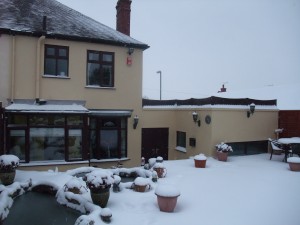 The housing market is an incredibly fascinating market to monitor and to research. The market was at the centre of the financial crisis with some lenders accused of over-aggressively expanding their mortgage books and relaxing their lending criteria. The UK housing market of today looks very different to the market before the financial crisis. Nationally, house prices are stagnant while transaction numbers are less than half their pre-crisis level. The UK housing market appears almost as ‘cold’ as the recent weather!
The housing market is an incredibly fascinating market to monitor and to research. The market was at the centre of the financial crisis with some lenders accused of over-aggressively expanding their mortgage books and relaxing their lending criteria. The UK housing market of today looks very different to the market before the financial crisis. Nationally, house prices are stagnant while transaction numbers are less than half their pre-crisis level. The UK housing market appears almost as ‘cold’ as the recent weather!

As the first chart shows, the annual rate of house price inflation across the UK has been consistently close to or even below zero over the past couple of years. The latest figures from the Nationwide Building Society point to the average UK house price in the final quarter of 2012 being 1.1 per cent lower than in the final quarter of 2011. The figures from the Halifax concur with their estimate showing UK house prices 0.3 per cent lower year-on-year in the final quarter of 2012. This is a very different picture from that during the 2000s. As recently as 2007, the annual rate of house price inflation was in excess of 10 per cent.
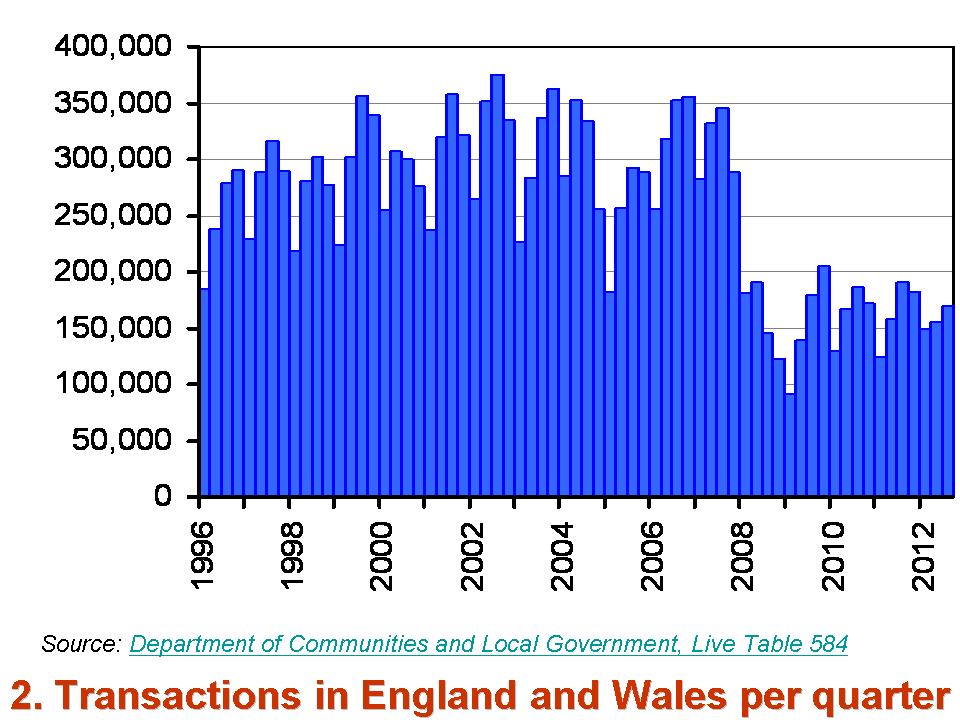 Another indicator of the changing face of the UK housing market is the level of activity. The second chart shows the number of transactions per quarter across England and Wales since 1996. The figures from the Department of Communities and Local Government show that since the start of 2010 England and Wales has seen an average of 159,000 transactions per quarter. This compares with an average of 294,000 transactions over the period from 1996 to the end of 2007. Hence, the number of purchases today is roughly half the level prior to the financial crisis.
Another indicator of the changing face of the UK housing market is the level of activity. The second chart shows the number of transactions per quarter across England and Wales since 1996. The figures from the Department of Communities and Local Government show that since the start of 2010 England and Wales has seen an average of 159,000 transactions per quarter. This compares with an average of 294,000 transactions over the period from 1996 to the end of 2007. Hence, the number of purchases today is roughly half the level prior to the financial crisis.
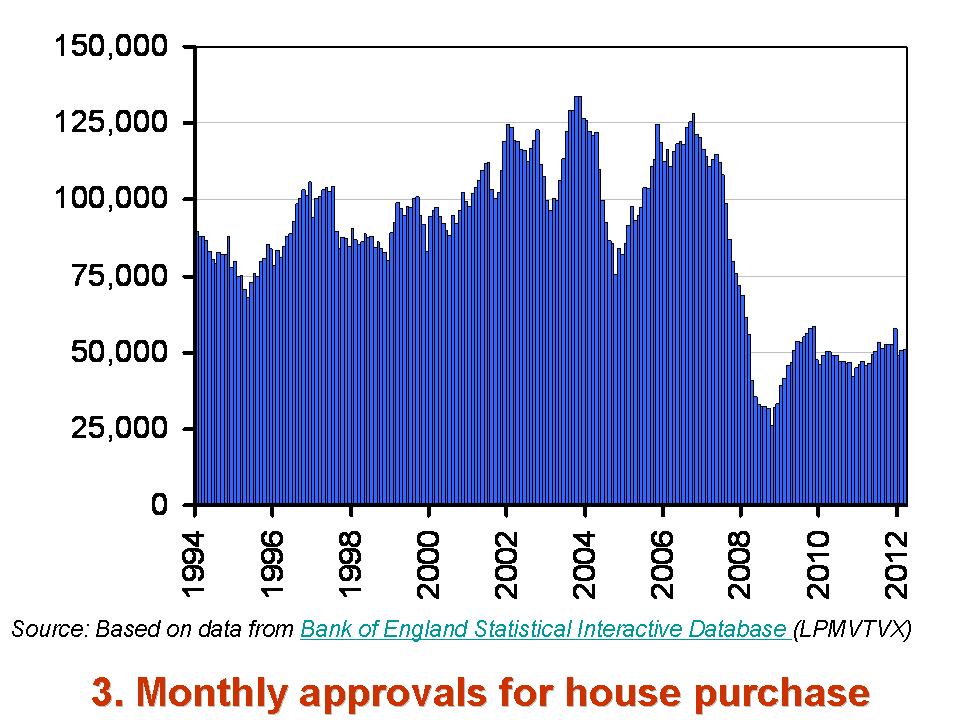 A further indicator of today’s very different housing market is the numbers of approvals by lenders for mortgages for house purchases. The latest Bank of England figures show that across the UK, the number of approvals each month in the first eleven months of 2012 averaged 51,000. Since 2010, the average monthly number of approvals has been 49,000. However, over the period from 1996 to the end of 2007 there were over 102,000 mortgages being approved each month.
A further indicator of today’s very different housing market is the numbers of approvals by lenders for mortgages for house purchases. The latest Bank of England figures show that across the UK, the number of approvals each month in the first eleven months of 2012 averaged 51,000. Since 2010, the average monthly number of approvals has been 49,000. However, over the period from 1996 to the end of 2007 there were over 102,000 mortgages being approved each month.
A trawl through some of the key indicators of the UK housing market helps to paint a picture of a market that is markedly different to that before the financial crisis. It would be a big surprise in today’s financial and economic climate if there were to be any significant change in the path of these indicators for some time.
Data
Statistical data set – Property transactions Department of Communities and Local Government
Nationwide house price index Nationwide Building Society
Halifax House Price Index Lloyds Banking Group
Lending to individuals – November 2012 Bank of England
Articles
UK house prices drop 1% Guardian, Hilary Osborne (3/1/13)
House prices on course to pass pre-crisis peak levels Telegraph, Roland Gribben (21/1/13)
House prices rise at highest rate in seven months Independent, Vicky Shaw (15/1/13)
UK mortgage market ‘now more robust’ BBC News, (21/1/13)
Bank of England report flags improving mortgage market Telegraph, Emma Rowley (21/1/13)
Questions
- Draw up a list factors that are likely to have affected each of our 3 indicators of the UK housing market (house price inflation, transactions and mortgage approvals) since the late 2000s.
- Using a demand-supply diagram, illustrate the forces that have affected house prices in the late 2000s and early 2010s.
- Draw up a list of issues surrounding the housing market that would be of interest to a microeconomist. Now repeat the exercise for a macroeconomist.
- Why are house prices so notoriously volatile? Can you think of any other markets where prices are similarly volatile? Do these markets share any common traits?
- If you were a commentator on the UK housing market what would you be forecasting for prices and activity in 2013?
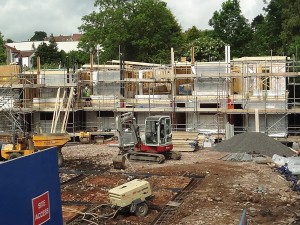 In an attempt to kick start the UK housing industry, the government has proposed a series of measures to reduce regulations.
In an attempt to kick start the UK housing industry, the government has proposed a series of measures to reduce regulations.
These include relaxing planning restrictions on building extensions to existing homes, shops and offices; relaxing current rules that all new housing developments should include affordable housing (which often makes little or no profit for the builders); an extra £280m for the FirstBuy scheme that provides loans to first-time buyers to raise money for a deposit; and a new “major infrastructure fast track” scheme, whereby developers of large commercial and residential projects currently stalled at local authority planning level can have their applications ‘fast tracked’ by the national Planning Inspectorate.
The government maintains that the measures will increase the flow of new houses coming onto the market by reducing ‘red tape’.

Critics maintain that the problem of the slump in house building has little to do with a lack of availability of new houses or new plots for building. Rather, it is a reflection of the recession in the economy as a whole. The solution, claim critics, is to stimulate the economy and then the new-build property market will recover along with other sectors.
The articles look at the likely success of these latest policy proposals for the property market.
Articles
David Cameron and Nick Clegg unveil plans to kick-start Britain’s ailing house building industry Independent, Oliver Wright (6/9/12)
Planning rules on extensions to be relaxed ‘to boost economy’ BBC News (6/9/12)
Q&A: Housing and planning shake-up BBC News (6/9/12)
 Government plans are recipe for planning blight, says LGA BBC News (6/9/12)
Government plans are recipe for planning blight, says LGA BBC News (6/9/12)
Scepticism greets home improvements plan Financial Times, George Parker and Gill Plimmer (6/9/12)
Extensions and loft conversions could add nearly a quarter to the value of homes Independent, Alex Johnson (10/9/12)
Green groups condemn relaxation of house-building planning rules GreenWise (6/9/12)
Construction figures deal blow to government housebuilding plans Guardian, Philip Inman (4/9/12)
House builders sitting on 400,000 undeveloped plots of land with planning permission The Telegraph (5/9/12)
Weak demand hits building sector Independent, Jamie Grierson (4/9/12)
Free up green-belt land for new housing, says Policy Exchange Guardian, Nicholas Watt (13/9/12)
Relaxing Planning Laws Will Damage British Housing Huffington Post, Martin Roberts (7/9/12)
Will David Cameron’s planning reforms create jobs and growth? Guardian, Juliette Jowit (6/9/12)
Data
Economic Data freely available online (see site 30 for links to housing market data) Economics Network
Lending to individuals Bank of England
Questions
- Distinguish between supply-side and demand-side policy and the different types of each.
- How would you classify the types of policy proposals announced on freeing up the new-build property market in terms of your answer to question 1?
- What will determine the success of the policy measures in stimulating (a) the new-build property market; (b) the economy generally?
- What externalities are involved in relaxing the regulations on home extensions?
- If you were in power, how would you go about stimulating the property market? Would there be any downsides of your proposals?
Some numbers are a newspaper editor’s dream! One such number this week was -3.6%. This was the fall in house prices in September reported by the Halifax (part of the Lloyds Banking Group). This certainly helped to alert a large audience to the downward momentum in house price growth that has been underway since about the start of the summer. While the Nationwide Building Society reported a 0.1% rise in September it is significant that both Halifax and Nationwide estimate that across the three months to September house prices actually fell by around 0.9%. In other words, the average UK house price fell by 0.9% in the third quarter of the year.
The annual rate of house price inflation, as the name suggests, compares house prices with the same point in time a year ago. The impact of the house price falls in the third quarter has been to reduce the annual rate of house price inflation to around the 3% mark. While the annual rate is still in positive territory, an obvious concern is how long this will be the case. Well, we can expect the annual rate to fall further because the UK saw strong house price growth in the final quarter of 2009 – the Nationwide estimates this to have been 2.2%. If I (Dean) was to throw my hat in the ring and hazard a guess as to the annual rate of house price inflation in the final quarter of 2010, I’d be inclined to say that it would be around the zero mark. If my crystal ball is found to be right, it would mean that house prices will end 2010 no higher than they finished 2009.
Now this is going to surprise you, but there has been considerable agreement amongst economists as to the reasons behind the recent house price falls. In short, it has been shifts in housing demand and supply. The evidence, such as that from estate agents, points to increases in houses prices during the second half of 2009 and the early part of this year as having induced additional housing supply. This means that estate agents saw instructions to sell increase strongly. People felt a little more confident about putting their property on the market and there was also a recovery in the volumes of new homes constructed.
So far, so good, you might think. But, as this year has moved on growing uncertainty about the economic environment and the on-going difficulties facing many potential buyers, especially first-time buyers, in obtaining mortgage credit, has contributed to a weakening of demand. The impact on the number of potential first-time buyers has been particularly acute because, by being increasingly credit-constrained, they have in effect become increasingly deposit-constrained too. The point is that buyers, especially first-time buyers, are being asked to find relatively large deposits to compensate for limited mortgage credit and both their limited ability and willingness to find these deposits is impacting on housing demand. So with a weakening demand we have been left with what Rightmove describes as a ‘supply hangover’. The effect has been for prices to fall.
It is a feature of housing markets that demand–supply imbalances induce considerable volatility in house prices. Going forward, it will continue to be the relative magnitudes of instructions to buy (housing demand) and of instructions to sell (housing supply) that will determine the path of house prices. Just how imbalanced will those estate agents books remain? How long will the supply hangover persist? Could supply increase further as people rush to sell and thereby further destabilising the market? Or will sellers begin taking property off the market, deciding that now is not the time to sell? Questions like these help to show just how real and how exciting the concepts of demand and supply are. Demand and supply are not concepts confined to the pages of textbooks they are alive and at work. The UK housing market demonstrates just how alive they are!
Articles
House prices record worst monthly fall ever Independent, Alistair Dawber (8/10/10)
Regions slip behind in bleak housing market Financial Times, Norma Cohen (8/10/10)
What next for house prices? Telegraph, Kara Gammell (8/10/10)
Fears grow for new market crash as house prices plummet Daily Record, Holly Williams (8/10/10)
Property price plunge blamed on need to sell The Herald, Helen McArdle (8/10/10)
Housing market crash feared after average house prices take record plunge Guardian, Jill Treanor (7/10/10)
UK house prices fell 3.6% in September, Halifax says BBC News (7/10/10)
Data
Halifax House Price Index Halifax (part of the Lloyds Banking Group)
Nationwide House Price Index Nationwide Building Society
Rightmove House Price Index Rightmove
Live Tables on Housing Market and House Prices Department of Communities and Local Government
Questions
- 2010 has been a year of contrasting fortunes for house prices. See if by using a demand and supply diagram you can illustrate the impact of demand and supply shifts on house prices in the first half of the year and then do the same again for more recent months.
- What do Rightmove mean by a ‘supply hangover’? What factors do you think will determine whether this effect persists?
- You become an estate agent. You buy 2 big books. One is to be used to record instructions to buy and the other instructions to sell. You have a meeting with your staff where you discuss those factors that you think will determine how full these two books will be from period to period. What factors do you think you are likely to identify? What impact would one book being fuller than the other have on house prices?
- Explain what we mean by a potential house buyer being credit-constrained. What is meant by a potential buyer being deposit-constrained? Why might first-time buyers be more deposit-constrained than other types of buyers?
- You often hear people talk about the housing market. But, what do we mean by a market? And what do we mean by a housing market? Do prices in all housing markets behave in the same way?
- We’ve seen that there are several institutions that publish an average house price figure. How do you think the likes of Halifax and Nationwide do this? What of Rightmove? Are there any other ways of estimating the average house price? Can you think of any problems that might arise with these estimates?
- It’s now your time for you to dust-off your crystal ball. Imagine that you are employed to write a monthly commentary on UK house prices. What would you expect to be reporting in the coming months?
You may have heard that house prices are stalling. August’s house price numbers from the Nationwide Building Society revealed that the average UK house price fell by 0.9% which came on the back of a 0.5% fall in July. The Nationwide talks of an ‘unwinding of the demand-supply imbalance that drove up prices for much of the last year’. It seems that the house price rises last year have, over recent months, induced additional supply by encouraging home-owners to put their property on the market. Unfortunately, there are indications that housing demand has weakened during 2010 though, of course, this gives buyers a greater degree of bargaining power.
But, you might wonder how we can get a handle on the strength of housing demand. Well, one particularly useful piece of information in assessing housing demand is the number of mortgage approvals for purchasing property. After all, there are not many of us that can reach into our back-pocket to find the £166,507 that the Nationwide estimates is needed to buy the average UK property.
If we look at Table A5.4 from August’s edition of Monetary and Financial Statistics, which is published by the Bank of England, we find that the number of mortgage approvals for house purchase in July was 48,722. Now, this was marginally up on the 48,562 in June, but, of more significance is the fact that July’s number was over 8% lower than in July 2009 when approval numbers stood at 53,126. Indeed, this number was to rise further through 2009, hitting 59,117 in November. This indicates a strengthening of housing demand at the time and helps us to appreciate why house prices rebounded last year.
But, the start of 2010 was to see mortgage approval numbers fall away and they have essentially flatlined over recent months at between 48,000 and 50,000. This time the numbers indicate a weakening of housing demand and so help to explain why house price growth has seemingly ceased and gone into reverse.
It remains to be seen how the balance between housing demand and supply will ‘play out’ over the remainder of the year. Will, for instance, some properties be taken off the market in response to this weaker demand? Could housing demand weaken further in response to economic conditions or to economic uncertainty? The answers to these questions will help to determine that all important balance between housing demand and supply. But, by monitoring the mortgage approval numbers we have a ready-made barometer on the strength of housing demand. Feel free to see which way the barometer needle swings in future!
Articles
UK mortgage approval rise but total lending weakest since March Telegraph (31/8/10)
House prices set to slump even further as home loans stay scarce Independent, Sean O’Grady (1/10/10)
Housing market ‘faces double dip’ Press Association (31/8/10)
UK mortgage approvals beat estimates as banks make more funds available Bloomberg, Scott Hamilton (31/8/10)
Data
Mortgage approval numbers and other lending data are available from the Bank of England’s statistics publication, Monetary and Financial Statistics (Bankstats) (See Table A5.4.)
Questions
- What variables do you think are important in affecting the level of housing demand?
- What variables do you think are important in affecting the level of housing supply?
- Using a demand-supply diagram illustrate how shifts in housing demand and/or supply may have affected house prices (i) during 2009 and (ii) during 2010.
- What would you expect to happen to the strength of housing demand in the coming months? How will this impact on house prices?
 As we reported in New Build: Foundations for a successful housing policy? the Autumn Statement heralded significant reforms to Stamp Duty – the UK tax on house purchases. The result is the introduction of a graduated system of tax, along the lines of the income tax system. A similar regime will continue to operate in Scotland when the Land and Buildings Transactions Tax replaces Stamp Duty next April. Here we consider the impact on the effective rates of tax following the changes to Stamp Duty.
As we reported in New Build: Foundations for a successful housing policy? the Autumn Statement heralded significant reforms to Stamp Duty – the UK tax on house purchases. The result is the introduction of a graduated system of tax, along the lines of the income tax system. A similar regime will continue to operate in Scotland when the Land and Buildings Transactions Tax replaces Stamp Duty next April. Here we consider the impact on the effective rates of tax following the changes to Stamp Duty. From Chart 1 we can see how the new average rate of tax under rises progressively with the price of the property. (Click here to download a PowerPoint of the chart). Under the old system, the profile of the average rate of tax looks like a series of steps with a slab at each tax rate. Unsurprisingly, the system was sometimes referred as the ‘slab system’.
From Chart 1 we can see how the new average rate of tax under rises progressively with the price of the property. (Click here to download a PowerPoint of the chart). Under the old system, the profile of the average rate of tax looks like a series of steps with a slab at each tax rate. Unsurprisingly, the system was sometimes referred as the ‘slab system’.  Chart 2 show the percentage change in the Stamp Duty liability for properties of up to £2.5 million. (Click here to download a PowerPoint of the chart.) The average UK house price, excluding London, is currently £235,000. The stamp duty saving in this case is £150 or 6.4 per cent.
Chart 2 show the percentage change in the Stamp Duty liability for properties of up to £2.5 million. (Click here to download a PowerPoint of the chart.) The average UK house price, excluding London, is currently £235,000. The stamp duty saving in this case is £150 or 6.4 per cent.  Autumn Statement: What do stamp duty changes mean? BBC News, (3/12/14)
Autumn Statement: What do stamp duty changes mean? BBC News, (3/12/14)




